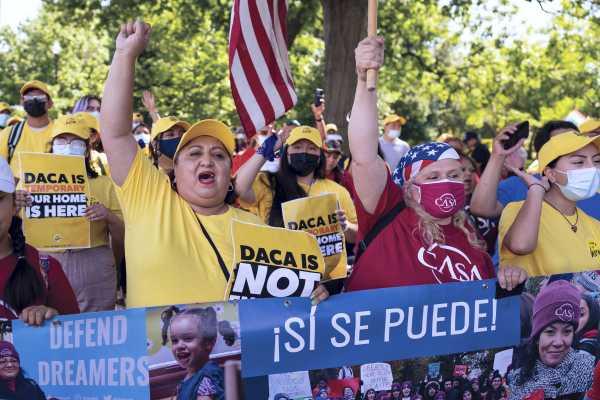
The Biden administration is again trying to shore up the Deferred Action for Childhood Arrivals (DACA) program against ongoing legal challenges that threaten to revoke protections for thousands of immigrants.
The effort is an important signal of the Biden administration’s commitment to the program, but is far from a perfect fix. While the more than 450-page final rule, effective October 31, would formally codify DACA as a federal regulation, it will offer current “DREAMers” — unauthorized immigrants who came to the US as children — little immediate protection. It also doesn’t allow any new DACA applications for now, narrowing its impact to the more than 600,000 people currently enrolled in the program.
“Today, we are fulfilling our commitment to preserve and strengthen DACA by finalizing a rule that will reinforce protections, like work authorization, that allow Dreamers to live more freely and to invest in their communities more fully,” President Joe Biden said in a statement on Wednesday.
What questions do you have about state politics?
Vox politics reporter Nicole Narea is here to help you unpack the fractured American political system and how it affects your life. Submit your question here.
Since former President Barack Obama created the program in 2012 via executive action, the program has shielded more than 800,000 DREAMers from deportation and allowed them to apply for work permits. Recent legal challenges to the program have put it in danger, however, leading the Biden administration to issue the new rule.
Because there are still more than two months until the rule goes into effect, the immediate status quo will not change, meaning those legal challenges still loom over the program, and DREAMers have no protection from any new challenges in the intervening period.
Even once the rule goes into effect, courts could still strike down the program as unlawful. If the rule is successfully implemented and Biden isn’t reelected in 2024, his successor could potentially overturn it, but would likely have to go through the arduous federal rulemaking process to do so. Because of all this, the rule is no substitute for codifying the program in federal law, which is the only ironclad measure that would ensure its survival against attacks from anti-immigrant hawks.
“While the Biden administration’s new rule sends a clear message that DACA works, our communities need more,” Marielena Hincapié, executive director of the National Immigration Law Center, said in a statement. “Strengthening DACA is a crucial step, but it is not a substitute for congressional action.”
What the rule does — and doesn’t — do
The rule replaces the policy guidance laid out in the 2012 memo that created DACA, maintaining the preexisting criteria for eligibility and the process for DACA applicants to request work permits. It also affirms that DACA is not a form of lawful status, but that DACA recipients are considered “lawfully present” for certain purposes — and that they should not be prioritized for deportation.
But the rule is not a cure-all. Former President Donald Trump closed DACA to new applicants, but stopped short of dismantling the program altogether after the Supreme Court prevented him from doing so in a June 2020 ruling. The Biden administration briefly resumed processing new applicants, approving some 1,900 individuals for DACA status in the first five months of 2021, before a Texas federal judge ordered it to stop. Roughly 1.1 million individuals would have been eligible to apply for the program as of the end of 2021. For now, that court order remains in place, even despite the new rule.
Immigrant advocates have also been calling on the Biden administration to update the eligibility criteria for the program, which they argue is outdated. Under the current criteria, applicants must have been under the age of 31 as of June 15, 2012, and have continuously resided in the US since at least June 15, 2007, among other requirements. Those eligibility dates haven’t been updated since the program was created.
The Department of Justice didn’t immediately respond to comment as to why the rule did not update the eligibility requirements, but it’s likely out of fear of legal challenges.
The fact that the rule cleared the federal rulemaking process — which involved soliciting and reviewing more than 16,000 comments from the public — might make it more robust to legal challenges than the 2012 memo. But the program is still under immediate threat from a pending lawsuit in the US Fifth Circuit Court of Appeals, and additional challenges to the rule are anticipated.
If the Fifth Circuit strikes down DACA as expected, an average of 5,000 DACA recipients each week for the next two years will lose their ability to work and become vulnerable to deportation, according to Todd Schulte, the president of the immigrant advocacy group FWD.us.
“Given this fact, it is absolutely critical for current DACA recipients to seek renewals as soon as they are eligible and consult with a lawyer about their options,” he wrote in a statement for the group on Twitter.
DACA has been a victim of gridlock in Congress
Versions of the DREAM Act, which would have codified the DACA program in federal law and provided a path to citizenship to DREAMers, have failed to pass for years.
In March 2021, a round of bipartisan negotiations fizzled out. A bipartisan group of senators — including Sens. Dick Durbin (D-IL), Alex Padilla (D-CA), Thom Tillis (R-NC) and John Cornyn (R-TX) — restarted immigration reform talks in April, but have yet to achieve any meaningful progress.
One reason for that is Republicans have shown little interest in passing the DREAM Act or similar legislation unless it’s paired with beefed-up border security measures, something Democrats have rejected. Because of Democrats’ one-vote majority in the Senate, however, they need Republican buy-in to overcome any filibuster and to pass legislation.
Democrats tried to go it alone last year and pass immigration reforms in a social spending bill through budget reconciliation, which only requires a simple majority to pass, but the Senate parliamentarian rejected several of their proposals, arguing the new policies violated reconciliation rules.
Immigration reform remains broadly popular: A June 2021 poll by the American Civil Liberties Union found that 72 percent of voters support the DREAM Act. Polling like that has done little to sway GOP lawmakers, however, and with the midterm elections months away, Republicans have even less incentive to help Democrats realize their long-term goal of protecting DREAMers.
And, by delaying action, Republicans may be able to strengthen their bargaining position on the issue. If Republicans retake control of the House, as is widely expected, the odds of passing the DREAM Act without Democrats’ acquiescing to at least some GOP demands on the border are incredibly slim.
If there’s any glimmer of hope for DREAMers, it might be in the Senate’s compromise on another highly divisive topic: gun control. Congress had been at an impasse on gun control since the 2012 shooting at Sandy Hook Elementary School in Newtown, Connecticut. But a series of major mass shootings finally galvanized enough bipartisan support to pass a gun safety package earlier this year that didn’t go as far as Democrats wanted, but still introduced tailored reforms. With the right motivation, immigration advocates hope a similar sort of negotiation might be possible on immigration, as well.
Will you support Vox’s explanatory journalism?
Millions turn to Vox to understand what’s happening in the news. Our mission has never been more vital than it is in this moment: to empower through understanding. Financial contributions from our readers are a critical part of supporting our resource-intensive work and help us keep our journalism free for all. Please consider making a contribution to Vox today.
Sourse: vox.com






